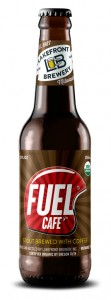I recently decided to steer toward darker beers, and to my wonderful surprise there are still breweries making them. I picked up a few to chase away the bitter winter blues, hoping against hope that perhaps I might actually be able to enjoy a malty, warming little treat.
First up is a coffee stout, because apparently no one can make stouts or porters without coffee anymore. Not that I’m really complaining, since long-time readers will know that I have a very intimate relationship with coffee beers, but it would be awfully nice to see a good roasty porter stand on its own.
This brew is called Fuel Café, brought to us by Lakefront Brewery out of Milwaukee. It promises that every ingredient is organic, from the barley to the hops to the coffee. These are the same brewers behind New Grist, so I shouldn’t be surprised at the all-organic angle.
It’s refreshingly rich and roasty with a sweet chocolate-malt body and a coffee flavor that’s present, but doesn’t dominate the brew. Rather it’s relaxing in the corner sketching in a notebook in order to get out its artsy angst. This sets it apart from a lot of coffee beers that usually have a powerful espresso-type flavor profile. It’s clearly a coffee beer, but it’s not so insecure that it needs to remind you of that with every sip.
Next on my agenda is the Sierra Nevada West Coast Style Stout. I have to admit, this is an interesting idea. I wonder what the West Coast has in store for me with this beloved dark beer style — aaaaand it’s a black IPA.
The loud thud you just heard was my head hitting the desk.
I was certain the black IPA craze had died out in 2013, but apparently it still hangs over our heads like the ghost of beer styles past. I will say that in terms of black IPAs, it’s not bad. Although the blending of West Coast style with a dark malty brew is a bit of a mixed bag flavor-wise, the end result isn’t too offensive. Actually, in the right light, this could be very tasty. However, this beer seems to suffer from what I like to call “doing the math with the wrong numbers.”
It might seem elementary to plug dark malts into a West Coast IPA recipe and call it a day, but personally, I feel this needed a bit more tweaking. There’s a bit of a disconnect between the potent, bitter hops and the dark malt of the stout. Ideally, there should be some connecting flavor that binds these two disparate tastes, but that is sorely missing here. It’s not a bad beer, but it’s got a bit of an identity dysphoria; it’s neither an IPA nor a stout, trying to be both and neither at the same time. I’ve heard the term “American stout” tossed around here and there, but I liken that term to “freedom fries” — a label attached to something that didn’t need it in the first place.
It’s a great stout for hop-heads, and I don’t dare try to curb the creativity that went into it, but I think this beer needs to take a little time to truly find itself.